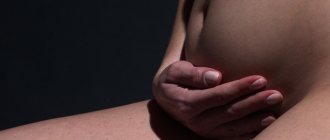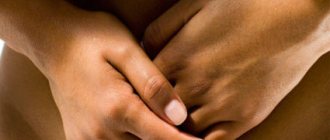The process of bringing a child into the world is a real miracle, which is accompanied by extraordinary processes in a woman’s body. Preparing a woman for pregnancy is quite popular, but preparing for childbirth is no less important. It is more complex and significant, because it is impossible to predict possible risks and necessary measures that will have to be taken during childbirth. Today we will look at the incision during childbirth, what it is called, when, under what conditions, why it is done, and whether it is harmful for the child.
Anatomical characteristics of the incision
In science, this procedure is called an episiotomy. It is allowed to make an incision during childbirth only in the second stage of labor. This stage is characterized by the baby being at the exit of the pelvis. The baby’s head is located in this place; even if there is no pushing, it does not go back, but remains in the small pelvis. This period is called head eruption, that is, the baby is already visible.
At the moment, in 95% of cases, an incision is used along an oblique line, towards the ischial tuberosities. If you look at the baby's head directly, you need to make cuts diagonally in the lower left corner. The length of the incision is approximately 2 cm.
Other cases are characterized by an incision in a straight line to the anus. This method is more complex and is not used unnecessarily in practice. This type of incision is already called perineotomy. The size and direction of the incision during childbirth depend on the individual characteristics of the woman and the birth process. Please note that due to the fact that the muscles are tense and the skin is thin, the woman is not given pain medication. She feels no pain from the incision.
Postoperative period
takes about two weeks for the stitches after an episiotomy to close.
b. A pregnant woman should not sit down while recovering from an episiotomy. When the healing period comes to an end, she may be allowed to sit on only one buttock, but with the condition that she will be in contact with the surface with the healthy side of the perineum, while her legs should be brought together. Before feeding the baby, pregnant women need to take a lying position.
After completing the episiotomy, treat the sutures with a concentrated solution of potassium permanganate. Subsequently, the woman in labor must adhere to a laxative diet, which will facilitate easier passage of stool and help prevent the sutures from coming apart. When a pregnant woman is discharged, she needs to regularly wash the external genitalia, using boiled water, after regular bowel movements.
For an episiotomy, recovery involves regularly changing pads every four hours. For this purpose, napkins are used, on which levomekol ointment is previously applied.
which helps speed up the healing process. Before it is possible to return to normal sexual activity, a woman will have to endure a rather long rehabilitation period of two months.
Indications for the procedure
Despite the fact that a surgical incision during childbirth is a better option than natural tissue rupture, the procedure requires special indications:
- Creating an immediate threat of tissue rupture when the skin around the perineum becomes very thin and begins to shine.
- The large size of the fetus is determined before birth, so an incision during childbirth is not an emergency, it is planned in advance.
- Premature birth, when the risk of injury to the baby increases.
- Shoulder dystocia, when the baby's head has already come out, and the shoulders cannot fit through due to their large size.
- If any obstetric operations are scheduled during childbirth, the procedure must also be performed.
- The incision during childbirth is vital to shorten the second stage of labor. This is necessary if blood pressure is high, the baby’s heart defect is diagnosed, and the second period has already lasted too long.
- Fetal hypoxia begins and actively develops when the child lacks oxygen.
- The baby is incorrectly positioned, it is in the pelvic area, this is called “breech presentation”.
- Muscle rigidity is a phenomenon in which the muscles are so weak that they cannot create a full push for the baby to come out.
- When a woman is unable to push on her own.
Is it possible to avoid it?
Doctors say that it is not always possible to avoid incisions, but it is quite possible. And the method is very simple and banal - gymnastics. If you systematically perform exercises that are aimed at increasing the elasticity of the perineal tissue, then the risk of tears and cuts is sharply reduced.
The simplest and most effective are the so-called Kegel exercises:
- Tighten your perineal muscles, slowly count to three, then relax. You can also squeeze the muscles and hold them in this state for up to 20 seconds.
- Squeeze your muscles a little (as if going up an elevator, 1st floor), hold for 3-5 seconds and continue lifting, squeezing a little harder (2nd floor), hold and gradually reach your limit. “Go down” in the same stages, lingering for a couple of seconds on each “floor”.
- Tighten and relax your muscles as quickly as possible for several minutes.
- Push from time to time, as if you are having a bowel movement.
By the way, you need to perform these exercises in the postpartum period.
Don't be lazy! Good luck!
Especially for
— Tanya Kivezhdiy
Childbirth is a very important and exciting moment. The closer the long-awaited date is, the more the woman begins to worry about how everything will go. Some expectant mothers, having heard enough horror stories from friends about how they were “cut,” begin to worry even more. So is it possible to give birth without incisions and tears, and what preventive measures should be taken?
Cutting technology
The first and mandatory condition for an incision during childbirth is time - it can only be done during the second phase of labor at the moment of maximum effort. Before making the cut, you need to treat the tissue with an antiseptic. If the tissues are not stretched sufficiently and the procedure may cause pain, an injection of Lidocaine is given:
- The incision is made with surgical scissors. During the period of rest of the woman in labor between attempts, one part of the scissors (blade), called the brush, is inserted into the gap between the baby’s head and the tissues. The direction must be maintained in the same direction as the cut will be made.
- The length of the incision should not exceed 3 cm; a very short incision may be ineffective, while a long one may cause harm, leading to rupture.
- There is no suture at this stage; after the placenta is delivered, the doctor examines the patient and the uterus, after which he applies sutures. Anesthesia is given before the suture is applied. After birth, the incision is no longer made, it is only sutured. The stitched area is treated with an antiseptic, and this is where the procedure ends.
There are two main methods for suturing the resulting incision. Let's look at each of them.
Recommendations for facilitating childbirth
The main rule: the calmer the woman in labor, the faster and easier the birth.
How to help yourself:
- learn relaxation techniques, breathing techniques and self-massage - you can learn about this in classes on preparation for childbirth at the antenatal clinic or at schools for expectant mothers;
- In the first period, it is better to behave actively - walk, make various movements, look for a comfortable position. During contractions, it is important not to hold your breath, breathe correctly, the worst thing you can do is scream;
- during the pushing period - listen to the doctor, he will tell you when to push and when, on the contrary, to relax. This way you will help reduce the birth tumor in the child and avoid ruptures in yourself.
Stitching in layers
The incision is sutured starting from the mucous membrane of the vaginal wall, after they are sutured, they move on. All cut muscle tissues are connected with submerged sutures. Synthetic threads that can be absorbed are used. Catgut is a thread made from animal intestinal fibers, which is sometimes used for suturing, but is prohibited in this case. It may cause allergies. The second layer is applied with cosmetic stitches; they are small and continuous.
Recovery after surgery
Recovery in this area is very inconvenient, especially considering that the woman has a newborn who requires constant care and protection. The inconvenience is that microorganisms are constantly present in the genital tract, which can get into the wound and cause inflammation. Bandaging and permanent treatment are not possible. If an incision was made during childbirth, you must abandon the sitting position, otherwise the stitches will come apart. As a general rule, it is forbidden to sit for 2 weeks, but everything is individual, depending on the level of regeneration and the depth of the incision. The period may last up to 4 weeks. It turns out that only lying and standing positions are allowed.
Healing of sutures
Postpartum sutures after an incision heal in about 5-7 days, if the area is treated correctly and the recommendations given by the doctor are not violated, and there are no infections. After the first week from the moment of suturing, the doctor removes the surface sutures and checks the condition of the scar. During the healing period, you must adhere to the following rules:
- Daily treatment of sutures - midwives in the maternity hospital, as a rule, treat them with brilliant green, while the condition of the young mother is assessed.
- After a shower, you need to lie naked for a while so that the woman dries naturally, otherwise you can get an infection. You can wipe the seams only with blotting movements with a clean material.
- After each trip to the toilet, you need to rinse the area with a weak solution of potassium permanganate.
- Apply sanitary pads and change them every 2 hours.
- You cannot lift anything heavy, the only exception is a child; you cannot touch anything heavier than him.
- To drink a lot of water.
- Train your muscles with Kegel exercises.
Full recovery occurs 2 months after the procedure. Pay attention to the photo of the incision during childbirth, it shows how it should look. You need to be attentive to your health and if you experience any ailments, consult a doctor. It is the complications that will be discussed further.
Possible complications
Complications of episiotomy include suppuration of the sutures or their dehiscence. Of course, medical personnel may be to blame for complications, but a lot also depends on the woman. It is necessary to observe the rules of hygiene and follow all doctor’s recommendations for caring for sutures.
In addition, if the sutures are placed incorrectly, a hematoma may form. This complication is usually detected in the first 2 hours after birth, while the woman is still in the maternity ward. In this case, it is necessary to open and remove the hematoma and re-suturing. This operation is performed under general intravenous anesthesia.
If, in addition to the incision, there are significant tears in the tissue of the birth canal, antibiotics are prescribed to prevent complications. They are also necessarily prescribed after removal of the hematoma.
Consequences
Not everything goes as smoothly as we would like, and if an incision was made during childbirth, and mistakes were made during the recovery period, there may be complications:
- Swelling of the incision, which is treated with ice. It is applied to the incision site, and an anesthetic is additionally applied.
- Dehiscence of the seams can occur due to a sitting posture or heavy stress. In this case, new sutures are applied and the treatment process begins from scratch.
- Infection in the wound, which can only be treated with antibiotics. If the conditions are favorable, the sutures are removed and the wound is drained, removing pus and fluid.
- The appearance of a hematoma - in this case, you need to immediately remove all the stitches and clean the wound from pus, rinse with a disinfectant, prescribe a course of antibiotics and begin treatment.
- Pain during intercourse. This is an unpleasant, but quite normal feeling; women experience pain during intimate relations during the first three months. After about a year, complete recovery occurs.
Home birth
The situation is ambiguous, on the one hand - no one can prohibit you from giving birth at home, and on the other hand, those who are present at the birth and help you - be it a husband, mother, neighbor or midwife - can be prosecuted under Article 235 of the Criminal Code Code of the Russian Federation as persons illegally engaged in medical activities. Even if a midwife has education, certification and work experience, she has no right to deliver births at home; private midwifery practice is prohibited by law . You can only get such help in public or private clinics. It is difficult to imagine a truly experienced certified specialist who would risk his reputation and freedom by delivering an arranged birth.
At home they eat straw, but when away they don’t even eat oats.
Russian folk proverb
https://sbornik-mudrosti.ru/poslovicy-i-pogovorki-o-dome/
Of course, it is much more comfortable, both physically and psychologically, to give birth at home. Some people are afraid of the unreasonable use of drugs, others are afraid that the birth will be carried out in a way that is more convenient for the medical staff, others do not want to expose the child to the danger of a hospital-acquired infection, and there can be many such reasons. But... When giving birth in a hospital, you have full access to emergency medical care in case of unforeseen circumstances. Even with an ideal anamnesis during childbirth, for example, prolapse of umbilical cord loops, severe bleeding, and the need for resuscitation measures for the child are possible . At home there will be no conditions for solving these problems, and you may not have time to get to the hospital...
I don’t have the most rosy memories of my stay in the maternity hospital, but I am convinced that responsible motherhood involves acting in the interests of the child, and not ensuring one’s own comfort. Ideally, it is possible to give birth in a hospital with “soft” conditions close to home.
But not everyone shares my point of view; among the celebrities who chose home birth are Glafira Tarkhanova and Maria Golubkina. Many women in the West also successfully give birth at home. But there the situation is somewhat different - certified specialists assist in childbirth, who have the necessary equipment, tools and drugs to provide resuscitation, and oxygen. And next to the house there is an ambulance on duty.
Reviews from patients and opinions of doctors
As we understand, episiotomy is a necessary measure that does not need to be resorted to if childbirth is proceeding normally. Let's turn to the opinion of experts.
Gynecologists indicate that up to 45% of all births are accompanied by this obstetric operation; it is the safest and best option for complications during labor. Episiotomy is necessary and useful only when there is an indication for it; doing it just like that is strictly prohibited.
Reviews from many women in labor show that you need to talk with the obstetrician before the moment of birth, discussing with him all the nuances and expressing your opinion regarding the obstetric operation. There are often cases where doctors play it safe and perform an episiotomy in cases where they can do without it. Be healthy and do not resort to surgery again!









